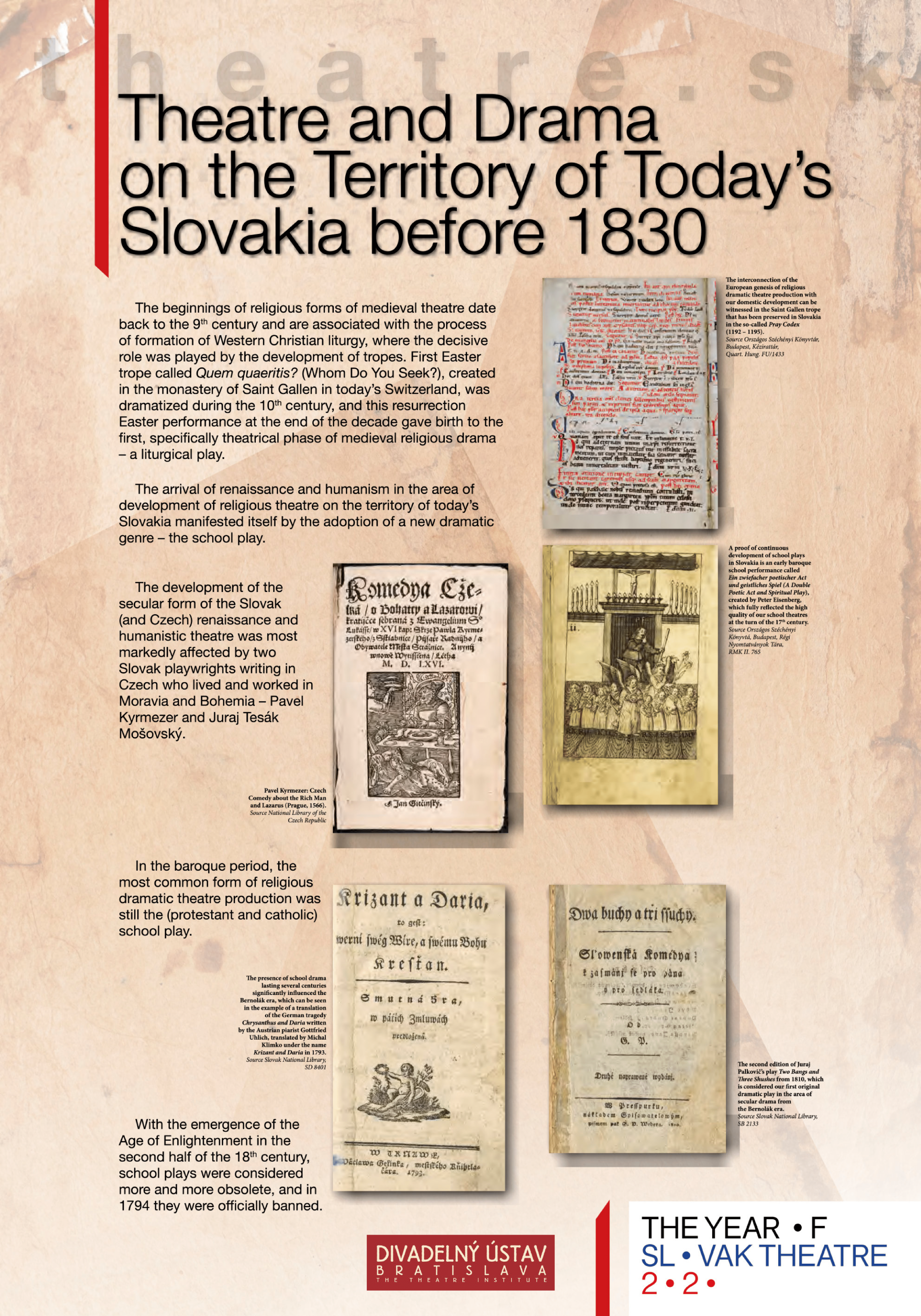
The History of Slovak Theatre – 1. Slovak Theatre before 1919
Theatre and Drama on the Territory of Today’s Slovakia before 1830
The beginnings of religious forms of medieval theatre date back to the 9th century and are associated with the process of formation of Western Christian liturgy, where the decisive role was played by the development of tropes. First Easter trope called Quem quaeritis? (Whom Do You Seek?), created in the monastery of Saint Gallen in today’s Switzerland, was dramatized during the 1Oth century, and this resurrection Easter performance at the end of the decade gave birth to the first, specifically theatrical phase of medieval religious drama – a liturgical play.
The arrival of renaissance and humanism in the area of development of religious theatre on the territory of today’s Slovakia manifested itself by the adoption of a new dramatic genre – the school play.
The development of the secular form of the Slovak (and Czech) renaissance and humanistic theatre was most markedly affected by two Slovak playwrights writing in Czech who lived and worked in Moravia and Bohemia – Pavel Kyrmezer and Juraj Tesák Mošovský.
In the baroque period, the most common form of religious dramatic theatre production was still the (protestant and catholic) school play.
With the emergence of the Age of Enlightenment in the second half of the 18th century, school plays were considered more and more obsolete, and in 1794 they were ofiicially banned.
Slovak Theatre before Professionalization 1830 – 1919
The development of amateur theatre on the territory of today’s Slovakia was primarily influenced by the German and Hungarian theatre. The dramatic efforts of amateurs were concentrated in multiple cultural centres – in Brezno, Sobotište, Levoča, Martin, Tisovec, Banská Štiavnica or in Banská Bystrica. The official birthday of the Slovak amateur theatre is 22 August 1830, when in Liptovský Sv. Mikuláš, over the summer holidays, Gašpar Féjerpataky-Belopotocký with his students staged Ján Chalupka’s comedy Kocúrkovo. The most prominent playwrights of this time included Ján Chalupka, Ján Palárik, and later Ferko Urbánek. Their comedies became the basis for the repertoires of the Slovak amateur theatres.
The beginnings of the Slovak dramatic activities were significant particularly for their national revival efforts. With the help of Samuel Jurkovič, teacher and later also notary public in Sobotište, the Bratislava students founded the Slovak National Theatre in Nitra on 5 August 1841. In addition to the Bratislava youth, the theatre company included the local enthusiasts from the Sobotište community.
The second half of the 19th century was most favourable for the Slovak nation and culture. Matica slovenská was founded in Turčiansky Sv. Martin (1863), and three Slovak high schools opened in Revúca, Turčiansky Sv. Martin and Kláštor pod Znievom. The energetic theatre activities gradually spread to other Slovak cities – Trnava, Prešov, Nitra, Banská Bystrica, Banská Štiavnica, Trenčín, Žilina. In addition to Liptovský Sv. Mikuláš, Turčiansky Sv. Martin became a significant centre of amateur theatre. Amateurs from Liptovský Sv. Mikuláš focused their work in Slovenská beseda, amateurs from Martin developed a more active dramatic portfolio after the foundation of Slovenský spevokol (1872).
This is an online version of exhibition theatre.sk.



